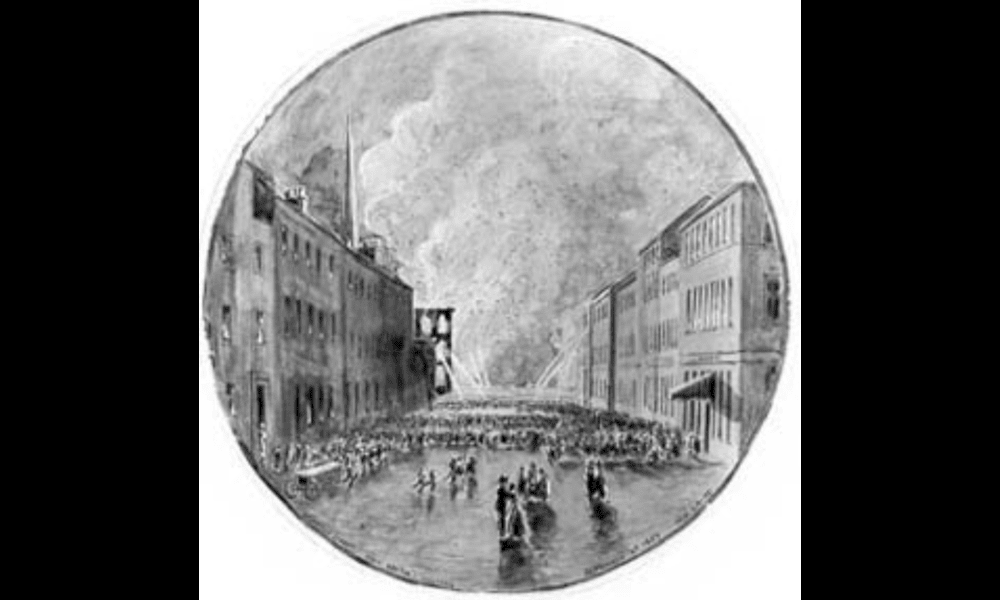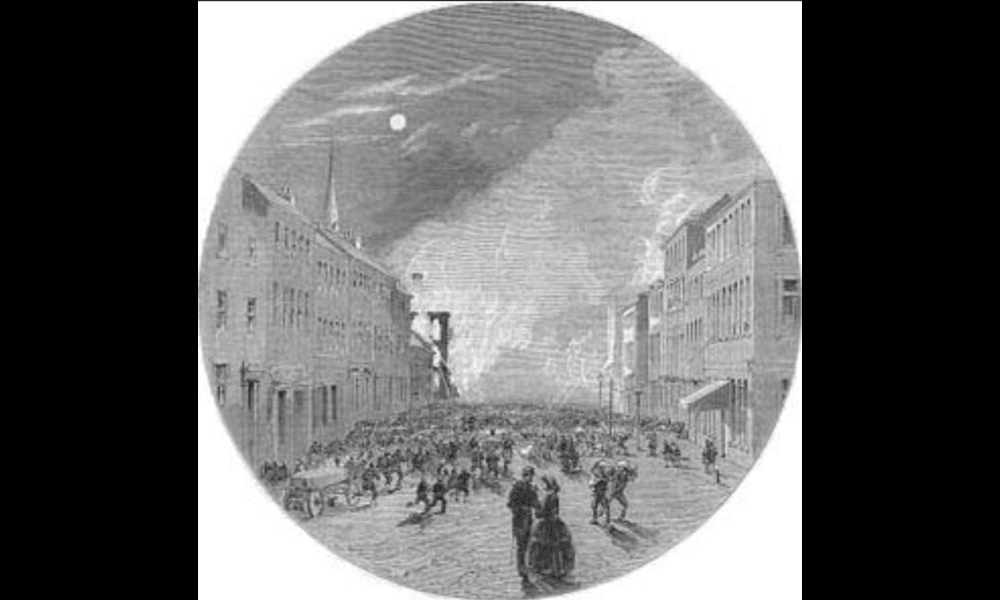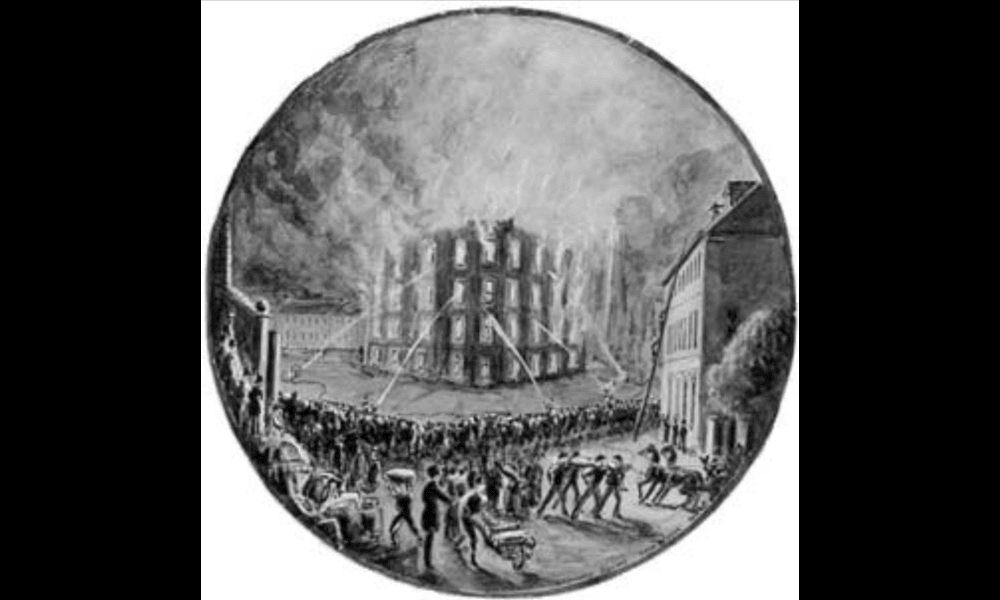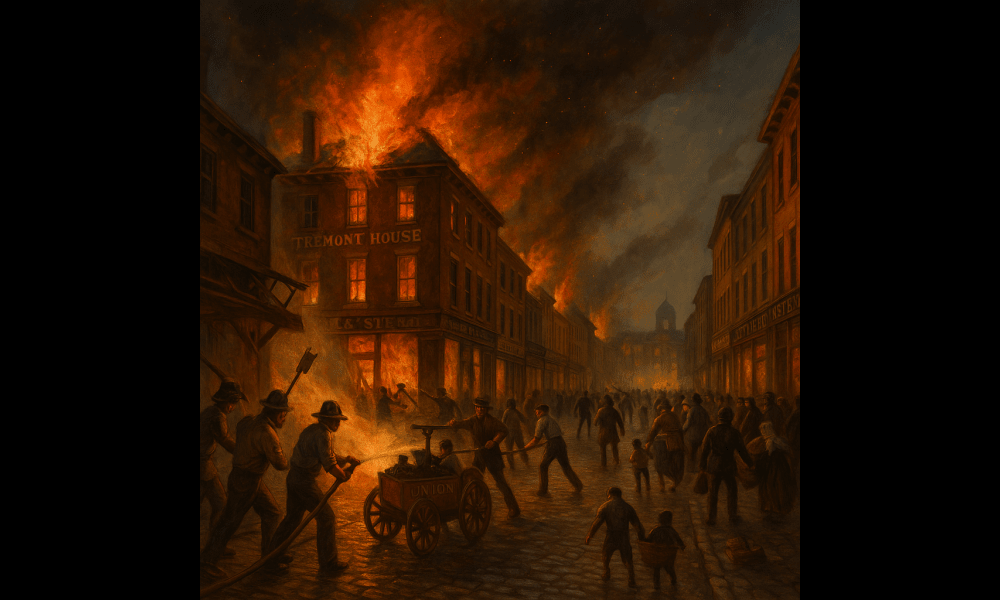Origin and Initial Spread
-
Ignition Site: The fire began in the basement of the Tremont House (a hotel located on the northeast corner of Granville and George Streets).
-
Time of Outbreak: Around 4:00 a.m. on September 9, 1859
-
Initial Cause: While the exact cause was never definitively confirmed, a suspicious origin was suspected, possibly accidental or due to negligence in the kitchen or furnace area.
Path of the Fire
-
The flames immediately swept northward along Granville Street, fueled by:
-
Highly flammable construction materials (wooden interiors and tarred roofs)
-
Strong southeast winds
-
-
George Street, Prince Street, and sections of Hollis Street were soon threatened.
-
The fire also reached the rear of the Provincial Building, severely endangering government records and archives.
Structures Lost
The fire destroyed more than 36 buildings, including:
Hotels & Public Buildings:
-
Tremont House Hotel – The starting point; completely destroyed.
-
Granville Hotel – Another well-frequented public house; lost to the flames.
-
Temperance Hall – Used by various societies and associations; totally consumed.
Government & Administrative Buildings:
-
The rear portion of the Provincial Building was scorched; though saved, its contents were removed in haste.
Commercial Stores & Warehouses:
-
Henry Heintzman's Piano & Music Store
-
W. & J. Stewart Dry Goods
-
Benjamin Kent & Sons
-
Joseph Salter & Co. (Ship chandlers)
-
Thompson's Grocery Warehouse
-
Morse’s China and Glassware Store
These stores were stocked with highly flammable merchandise, adding fuel to the fire’s intensity.
Printing Offices & Shops:
-
The office of the British Colonist newspaper was gutted.
-
Several bookstores and stationers lost stock, records, and equipment.
Firefighting Efforts
Fire Companies Present:
-
Hand in Hand Fire Company (called out but delayed in arrival)
-
Military Assistance: Members of the Halifax Garrison, particularly the Royal Engineers, were heavily involved in pumping water and clearing debris.
Equipment Used:
-
Hose reels, hand tubs, and hook & ladder apparatus were deployed.
-
Several engines had difficulty getting sufficient water pressure, especially north of Prince Street, where fire plugs were inadequate.
-
Citizens assisted with bucket brigades, forming lines to nearby tanks and fountains.
Tactical Response:
-
Multiple buildings were pulled down under orders from the firewards to create a firebreak.
-
The firewards and officers ordered forcible entry into nearby properties to remove goods and stop internal spread.
Community & Civilian Actions
-
Civilians helped evacuate residents from upper stories—some escaping via ladders and adjacent rooftops.
-
Many citizens helped move merchandise and furniture into the street or nearby churchyards for safekeeping.
-
The Temperance Society and Odd Fellows lost meeting records and regalia.
-
Property losses were unevenly insured—some completely uninsured merchants were financially ruined.
Aftermath & Reform
-
Damage Estimate: Over £80,000 in losses.
-
No fatalities were reported, but multiple minor injuries occurred from collapsing walls and falling debris.
-
The fire highlighted:
-
Weaknesses in water supply
-
Inefficiencies in the decentralized fire response
-
Lack of coordination among volunteer companies
-
-
Calls intensified for:
-
A centralized, professionally coordinated fire service
-
Improved hydrant systems and more reliable water pressure in the downtown core
-
New engine houses and updated equipment
-
These pressures helped accelerate the founding of the Volunteer Engine Company and Volunteer Axe Company just two years later in 1861, marking a new era in Halifax firefighting.
Letter from the Board of Insurance Companies of Halifax addressed to City Council.
From the City Council meeting minutes of September 15, 1859:
"Halifax N.S.
12th September 1859
To His Worship The Mayor And The Worshipful The City Council of Halifax.
Gentlemen,
The Board of Fire Insurance representing all the Fire Insurance Companies doing business in this City have deputed us to make the following communication to your Worship and your Worshipful Body.
The amount insured in our offices on property destroyed by the conflagration on the Night of Friday the 9th instant exceeds One Hundred and twenty six thousand pounds Currency, of which we have ascertained that we shall be called upon to pay upwards One Hundred Thousand Pounds.
Under these circumstances we trust that it will not be deemed presumptuous or officious to ask in reference to the late Fire that immediate and effective investigation be made, first into into the immediate cause of the Fire; secondly into the causes why a conflagration by which Three whole Blocks of Buildings (with the exception of Mr. Esson's Building) were totally destroyed, occuring at the early hour of Nine o'clock in the Evening, with a calm atmosphere and the advantage of Moon light, was not arrested in its progress. If it should be found on such investigation among other things that the supply of Water from the Water Company's Fire Plugs was deficient in force and quantity, that there was a great want of organization and method in the means employed, that the force of Firemen was altogether inadequate giving them credit for using all the exertions in their power, or that aid from the Military was not promptly given, these considerations will be suggestive of the remedies to be applied. And we fervently hope that effectual and energetic measures will be adopted without delay, and that no contracted ideas of ill advised economy will be allowed to interfere with the providing prompt remedies where such large interests are at stake.
If we might be permitted, we would respectfully suggest that a supply of Water should be provided by laying down a pipe of sufficient dimensions, not less than 12 Inches along the whole of Barrack Street with branch pipes leading down the hill to be used exclusively for Fires. That those of sufficient strength and length be obtained to be used with the above.
That a Steam Fire Engine should be immediately procured
The Illustrated London News, 15 October 1859, p.370, reported that:
"At nine o’clock on the night of the 9th of September the little metropolis of the province of Nova Scotia was startled by the unwelcome sound of the firebells. Soon it became known that the flames were at work in the very centre of its budding magnificence, and with a fury that bade defiance to all counter-efforts. Houses and stores, wooden, brick, and stone, all alike fed the flames, until, of the two extensive blocks touching on Hollis and Barrington streets, with Granville street (the Haligonian’s paradise), running betwixt them, nothing escaped except one store, by saving which, by the way, the fire was prevented spreading over the town. The damage is considerable – about £200,000; the insurance covers £131,000 of the loss. Sixty of the finest buildings in Halifax, covering four acres of ground, were destroyed; two lives were also lost, and many persons received severe injuries. The first of the accompanying Sketches [No. 38] gives a view of the fire in Granville-street, looking northward; the other [No. 39] represents the burning of a huge misshapen pile, nicknamed the ‘Coffin’, in Ordnance-square. From the brilliant play of colours caused by the combustion of the inflammable materials with which it was filled, and from the danger caused by the proximity of the Ordnance Magazine, the excitement here was intense."
Not noted in original source, however this is likely based on a watercolour by H.H. Laird; 23 cm diameter, as with other lithographs of this event published in the same edition of The Illustrated London News.





